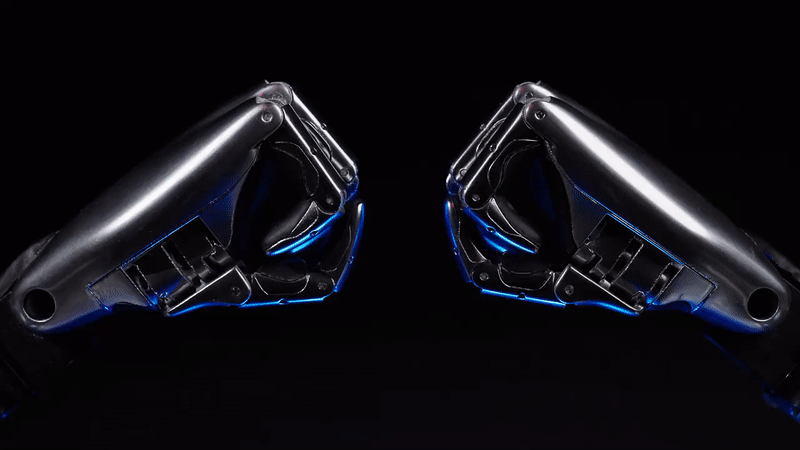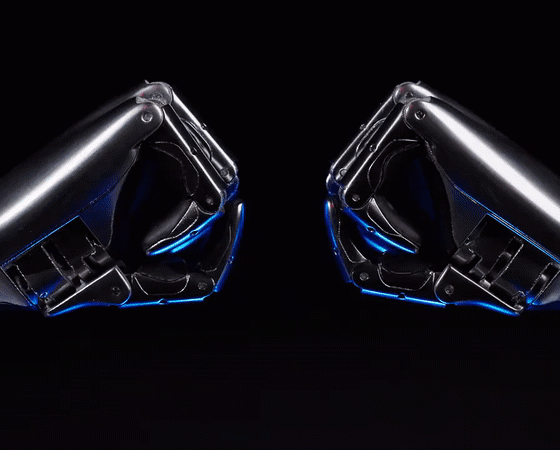

News
Tesla’s Elon Musk confirms AI Day 2 teaser features Optimus bot’s real hands
As it turns out, the new AI Day 2022 teaser that Tesla recently posted online depicted the real hands of Optimus, the Tesla Bot. This was confirmed by CEO Elon Musk in a recent response on Twitter.
AI Day 2022 is only a few hours away, and yesterday, Tesla’s official Twitter account posted a short video featuring robotic hands forming a heart. The video immediately caught the attention of Tesla watchers, especially since it featured a seemingly more mature design compared to the metal hands featured in AI Day 2022’s posters.

Commenting on the video, Musk stated on Twitter that the clip showed “the hands of Optimus.” And in a later tweet, the Tesla CEO confirmed that hands were “not CGI.”
Musk’s comments were quite in line with speculations from some members of the Tesla community, some of whom noted that the movements of the robotic hands in the teaser video were incredibly realistic. Part of it is due to the fact that the hand movements were actually not perfect.
As seen in the short teaser, the right and left hands were not perfectly synchronized. The right fingers could be seen brushing the thumb as the hands formed a heart shape, and the left and right thumbs were not fully aligned at the end. Amusingly enough, Optimus’ imperfect hand movements were used by Tesla skeptics as a point of criticism since it supposedly showed the incompetence of the company in its animation efforts.
Expectations are high that Tesla will be showcasing its humanoid robot extensively at AI Day 2022. In previous comments, Musk noted that the event, while highly technical, will also feature hardware demonstrations. Considering how prevalent Optimus has been in AI Day 2022’s invites and teasers, it would appear that the humanoid robot will be doing some notable demonstrations at the upcoming event.
Don’t hesitate to contact us with news tips. Just send a message to simon@teslarati.com to give us a heads up.

Elon Musk
GM CEO Mary Barra says she told Biden to give Tesla and Musk EV credit
“He was crediting me, and I said, ‘Actually, I think a lot of that credit goes to Elon and Tesla…You know me, Andrew. I don’t want to take credit for things.”

General Motors CEO Mary Barra said in a new interview on Wednesday that she told President Joe Biden to credit Tesla and its CEO, Elon Musk, for the widespread electric vehicle transition.
She said she told Biden this after the former President credited her and GM for leading EV efforts in the United States.
During an interview at the New York Times Dealbook Summit with Andrew Ross Sorkin, Barra said she told Biden that crediting her was essentially a mistake, and that Musk and Tesla should have been explicitly mentioned (via Business Insider):
“He was crediting me, and I said, ‘Actually, I think a lot of that credit goes to Elon and Tesla…You know me, Andrew. I don’t want to take credit for things.”
GM CEO Mary Barra said to Andrew Sorkin at the New York Times Dealbook Summit that she pulled President Biden aside and said Tesla CEO @elonmusk deserved the credit for EVs:
“He was crediting me, and I said, ‘Actually, I think a lot of that credit goes to Elon and Tesla,'” Barra… pic.twitter.com/OHBTG1QfbJ
— TESLARATI (@Teslarati) December 3, 2025
Back in 2021, President Biden visited GM’s “Factory Zero” plant in Detroit, which was the centerpiece of the company’s massive transition to EVs. The former President went on to discuss the EV industry, and claimed that GM and Barra were the true leaders who caused the change:
“In the auto industry, Detroit is leading the world in electric vehicles. You know how critical it is? Mary, I remember talking to you way back in January about the need for America to lead in electric vehicles. I can remember your dramatic announcement that by 2035, GM would be 100% electric. You changed the whole story, Mary. You did, Mary. You electrified the entire automotive industry. I’m serious. You led, and it matters.”
People were baffled by the President’s decision to highlight GM and Barra, and not Tesla and Musk, who truly started the transition to EVs. GM, Ford, and many other companies only followed in the footsteps of Tesla after it started to take market share from them.
Elon Musk and Tesla try to save legacy automakers from Déjà vu
Musk would eventually go on to talk about Biden’s words later on:
“They have so much power over the White House that they can exclude Tesla from an EV Summit. And, in case the first thing, in case that wasn’t enough, then you have President Biden with Mary Barra at a subsequent event, congratulating Mary for having led the EV revolution.”
In Q4 2021, which was shortly after Biden’s comments, Tesla delivered 300,000 EVs. GM delivered just 26.
News
Tesla Full Self-Driving shows confident navigation in heavy snow
So far, from what we’ve seen, snow has not been a huge issue for the most recent Full Self-Driving release. It seems to be acting confidently and handling even snow-covered roads with relative ease.

Tesla Full Self-Driving is getting its first taste of Winter weather for late 2025, as snow is starting to fall all across the United States.
The suite has been vastly improved after Tesla released v14 to many owners with capable hardware, and driving performance, along with overall behavior, has really been something to admire. This is by far the best version of FSD Tesla has ever released, and although there are a handful of regressions with each subsequent release, they are usually cleared up within a week or two.
Tesla is releasing a modified version of FSD v14 for Hardware 3 owners: here’s when
However, adverse weather conditions are something that Tesla will have to confront, as heavy rain, snow, and other interesting situations are bound to occur. In order for the vehicles to be fully autonomous, they will have to go through these scenarios safely and accurately.
One big issue I’ve had, especially in heavy rain, is that the camera vision might be obstructed, which will display messages that certain features’ performance might be degraded.
So far, from what we’ve seen, snow has not been a huge issue for the most recent Full Self-Driving release. It seems to be acting confidently and handling even snow-covered roads with relative ease:
FSD 14.1.4 snow storm Ontario Canada pic.twitter.com/jwK1dLYT0w
— Everything AI (@mrteslaspace) November 17, 2025
I found the steepest, unplowed hill in my area and tested the following:
• FSD 14.2.1 on summer tires
• FSD 14.2.1 on winter tires
• Manual drivingBut I think the most impressive part was how FSD went DOWN the hill. FSD in the snow is sublime $TSLA pic.twitter.com/YMcN7Br3PU
— Dillon Loomis (@DillonLoomis) December 2, 2025
Well.. I couldn’t let the boys have all the fun!
Threw the GoPro up and decided to FSD v14.2.1 in the snow. Roads were not compacted like the other day, a little slippery, but overall doable at lower speeds. Enjoy the video and holiday music 🎶
Liked:
Took turns super slow… pic.twitter.com/rIAIeh3Zu3— 🦋Diana🦋 (@99_Colorado) December 3, 2025
Moving into the winter months, it will be very interesting to see how FSD handles even more concerning conditions, especially with black ice, freezing rain and snow mix, and other things that happen during colder conditions.
We are excited to test it ourselves, but I am waiting for heavy snowfall to make it to Pennsylvania so I can truly push it to the limit.
News
Tesla hosts Rome Mayor for first Italian FSD Supervised road demo
The event marked the first time an Italian mayor tested the advanced driver-assistance system in person in Rome’s urban streets.

Tesla definitely seems to be actively engaging European officials on FSD’s capabilities, with the company hosting Rome Mayor Roberto Gualtieri and Mobility Assessor Eugenio Patanè for a hands-on road demonstration.
The event marked the first time an Italian mayor tested the advanced driver-assistance system in person in Rome’s urban streets. This comes amid Tesla’s push for FSD’s EU regulatory approvals in the coming year.
Rome officials experience FSD Supervised
Tesla conducted the demo using a Model 3 equipped with Full Self-Driving (Supervised), tackling typical Roman traffic including complex intersections, roundabouts, pedestrian crossings and mixed users like cars, bikes and scooters.
The system showcased AI-based assisted driving, prioritizing safety while maintaining flow. FSD also handled overtakes and lane decisions, though with constant driver supervision.
Investor Andrea Stroppa detailed the event on X, noting the system’s potential to reduce severe collision risks by up to seven times compared to traditional driving, based on Tesla’s data from billions of global fleet miles. The session highlighted FSD’s role as an assistance tool in its Supervised form, not a replacement, with the driver fully responsible at all times.
Path to European rollout
Tesla has logged over 1 million kilometers of testing across 17 European countries, including Italy, to refine FSD for local conditions. The fact that Rome officials personally tested FSD Supervised bodes well for the program’s approval, as it suggests that key individuals are closely watching Tesla’s efforts and innovations.
Assessor Patanè also highlighted the administration’s interest in technologies that boost road safety and urban travel quality, viewing them as aids for both private and public transport while respecting rules.
Replies on X urged involving Italy’s Transport Ministry to speed approvals, with one user noting, “Great idea to involve the mayor! It would be necessary to involve components of the Ministry of Transport and the government as soon as possible: it’s they who can accelerate the approval of FSD in Italy.”








